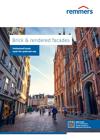The oldest bricks (still mud bricks) were found in 1952 during archaeological excavations in Jericho (7500 BC).

Along with wood, stone and plant fibres, bricks are among the oldest building materials known to humankind. Earthen clay is mixed with sand, moulded and fired in kilns. The first bricks were shaped by hand, giving them irregular dimensions.
The production of waterproof blocks by firing dried moulds of clay or loam was already common in ancient times. Unlike unfired clay, which softens as a result of water entering the molecular structure, fired clay is no longer plastically deformable. Heating to 800 to 1000 °C makes the clay waterproof. In the process, water is expelled from the pores in the brick. Air now occupies the freed pore space, and the structure is porous and water-absorbent. A denser structure can be achieved by further heating to 1200 to 1300 °C. At such high temperatures, melting starts to occur. This creates a largely waterproof clinker from a porous, water-absorbent brick.
Our refurbishment systems
-
Façade cleaning
-
Crack repair
-
Stone substitution systems
-
Joint repair
-
Impregnation and hydrophobic treatments
-
Anti-graffiti measures
-
Regeneration of roof cladding
Brochure – Brick and render façades

Peace of mind guaranteed
Benefit from our expert advice, our promise of optimum safety for our extensive product range, and our express delivery service.
Express delivery
Our express delivery is the ideal service for anyone who needs their order to be delivered fast.
Specialist representatives directly on site
Our specialist representatives are on hand to provide you with personalised support and advice – wherever you are.
Extensive product range
From building and floor protection products through to wood preservatives, we have everything you need!
Systems with Remmers guarantee
You can be sure of a reliable and high-quality solution for every application.




























